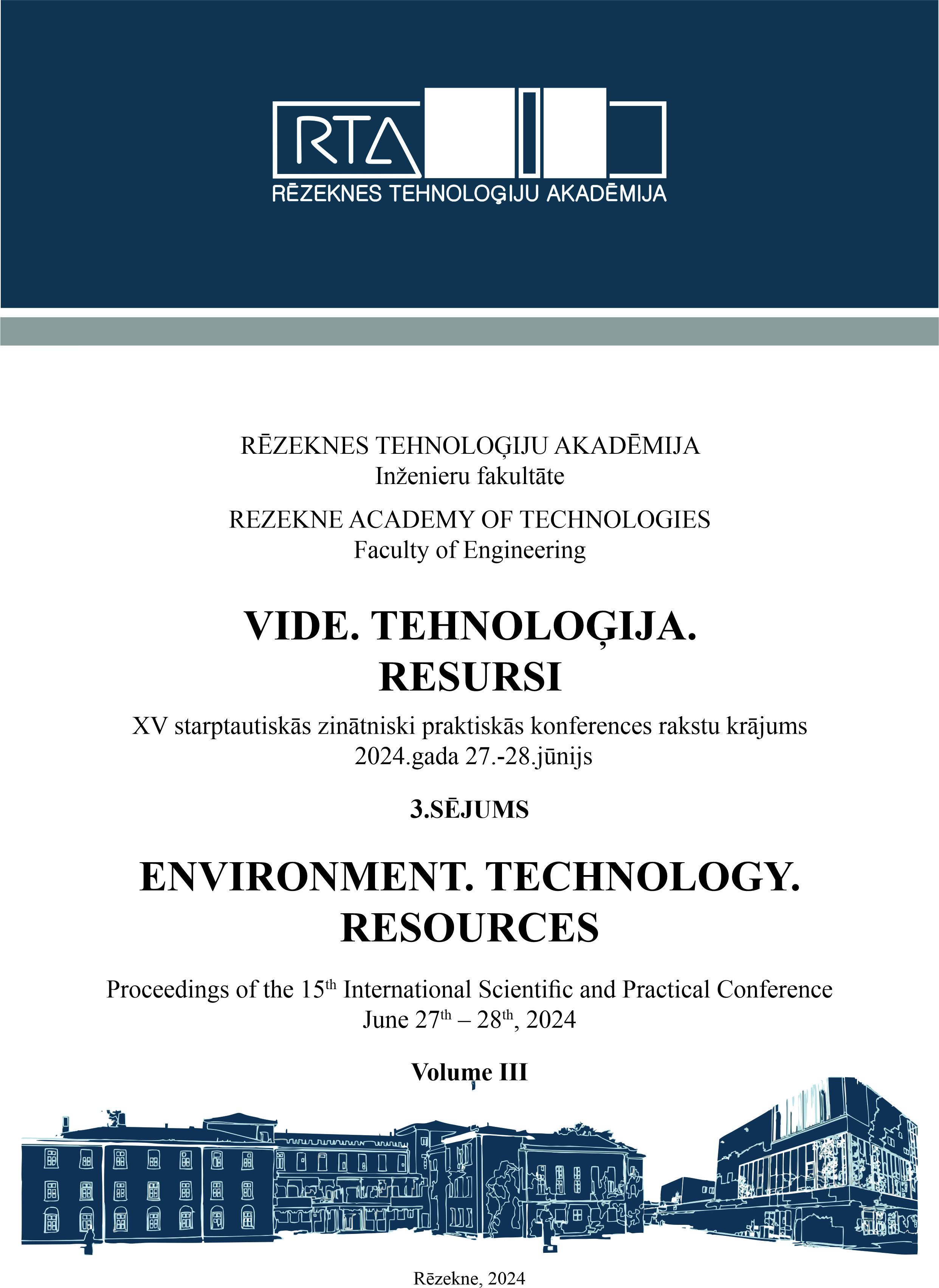OBTAINING A PROMISING LASER INDUCED SURFACE NANOSTRUCTURE OF TITANIUM ALLOY FOR BIOCOMPATIBILITY
DOI:
https://doi.org/10.17770/etr2024vol3.8181Keywords:
Biocompatibility, Nanotextures, LaserAbstract
Biocompatibility of materials is of paramount importance in many areas of research, engineering, medical and consumer grade product development. Biocompatibility of surfaces can be understood as resistance of the surface to harmful bacteria colonisation and subsequent biofilm creation. Traditionally, such surfaces are created by coating the base material with a different material that offers the necessary biocompatibility features. This is often not desirable, as it introduces different surface chemistry, has different physical properties than the base material, and in many cases, does not provide a lasting solution. Modification of the surface of the base material would be preferrable. In the last decade, laser ablation of surfaces to create microscale and nanoscale patterns that improve biocompatibility has been at the forefront of research in this field. This research paper provides insight into current understanding of bactericidal surface topologies and demonstrates an example of obtaining a potentially bactericidal surface of grade V titanium alloy with an industrial grade nanosecond laser.
References
Samaha, M. A., Tafreshi, H. V., & Gad-el-Hak, M. (2012). Superhydrophobic surfaces: From the Lotus Leaf to the submarine. Comptes Rendus Mécanique, 340(1-2), 18–34. https://doi.org/10.1016/j.crme.2011.11.002.
Zhang, X., Liu, X., Laakso, J., Levänen, E., & Mäntylä, T. (2012). Easy-to-clean property and durability of superhydrophobic flaky γ-alumina coating on stainless steel in field test at a paper machine. Applied Surface Science, 258(7), 3102–3108. https://doi.org/10.1016/j.apsusc.2011.11.045.
Wang, F., Li, C., Lv, Y., Lv, F., & Du, Y. (2010). Ice accretion on superhydrophobic aluminum surfaces under low-temperature conditions. Cold Regions Science and Technology, 62(1), 29–33. https://doi.org/10.1016/j.coldregions.2010.02.005.
Donlan, R. M. (2002). Biofilms: Microbial life on surfaces. Emerging Infectious Diseases, 8(9), 881–890. https://doi.org/10.3201/eid0809.020063.
Tripathy, A., Sen, P., Su, B., & Briscoe, W. H. (2017). Natural and bioinspired nanostructured bactericidal surfaces. Advances in Colloid and Interface Science, 248, 85–104. https://doi.org/10.1016/j.cis.2017.07.030.
Curtis, A., & Wilkinson, C. (1997). Topographical control of cells. Biomaterials, 18(24), 1573–1583. https://doi.org/10.1016/s0142-9612(97)00144-0.
Gasik, M., Braem, A., Chaudhari, A., Duyck, J., & Vleugels, J. (2015). Titanium implants with modified surfaces: Meta-analysis of in vivo osteointegration. Materials Science and Engineering: C, 49, 152–158. https://doi.org/10.1016/j.msec.2014.12.074.
Meyle, J., Gültig, K., Brich, M., Hämmerle, H., & Nisch, W. (1994). Contact guidance of fibroblasts on biomaterial surfaces. Journal of Materials Science: Materials in Medicine, 5(6-7), 463–466. https://doi.org/10.1007/bf00058984.
Linklater D.P., S. Juodkazis, E.P. Ivanova, Nanofabrication of mechanobactericidal surfaces, Nanoscale 9 (43) (2017) 16564-16585. https://doi.org/10.1039/c7nr05881k.
Ivanova E.P., et al., Natural bactericidal surfaces: mechanical rupture of Pseudomonas aeruginosa cells by cicada wings, Small 8 (16) (2012) 2489-2494. https://doi.org/10.1002/smll.201200528.
Kelleher S.M., et al., Cicada wing surface topography: an investigation into the bactericidal properties of nanostructural features, ACS Appl. Mater. Interfaces 8 (24) (2016) 14966-14974. https://doi.org/10.1021/acsami.5b08309.
Bandara C.D., et al., Bactericidal effects of natural nanotopography of dragonfly wing on Escherichia coli, ACS https://doi.org/10.1021/acsami.6b13666.
Mainwaring D.E., et al., The nature of inherent bactericidal activity: insights from the nanotopology of three species of dragonfly, Nanoscale 8 (12) (2016) 6527-6534. https://doi.org/10.1039/c5nr08542j.
Li X., et al., The nanotipped hairs of gecko skin and biotemplated replicas impair and/or kill pathogenic bacteria with high efficiency, Nanoscale 8 (45) (2016) 18860-18869. https://doi.org/10.1039/c6nr05046h.
Ivanova E.P., et al., Bactericidal activity of black silicon, Nat. Commun. 4 (2013) 2838. https://doi.org/10.1038/ncomms3838.
Hayles A., et al., Hydrothermally etched titanium: a review on a promising mechano-bactericidal surface for implant applications, Mater. Today Chem. 22 (2021), 100622, https://doi.org/10.1016/j.mtchem.2021.100622.
Islam, M., et al., Finite Element Modeling of a Gram-Negative Bacterial Cell and Nanospike Array for Cell Rupture Mechanism Study. (2023) Molecules. 28. 2184. 10.3390/molecules28052184.
Bhadra, C.M., et al., Antibacterial titanium nano-patterned arrays inspired by dragonfly wings. Sci. Rep. 2015, 5, 16817, https://doi.org/10.1038/srep16817.
Rofin. (2015). FIBER LASERS PowerLine F Series for Marking and Micro Processing. Bergkirchen, Germany; Rofin.
Pannier Corporation. (2021, November 29). Comparison: Galvanometer vs. flatbed laser marking. Pannier Corporation. Retrieved January 18, 2023, from https://www.pannier.com/laser/flatbed-vsgalvo-lasers/.
Larrañaga-Altuna, M., Zabala, A., Llavori, I., Pearce, O., Nguyen, D. T., Caro, J., Mescheder, H., Endrino, J. L., Goel, G., Ayre, W. N., Seenivasagam, R. K., Tripathy, D. K., Armstrong, J., & Goel, S. (2021). Bactericidal surfaces: An emerging 21st-century ultra-precision manufacturing and materials puzzle. Applied Physics Reviews, 8(2), 021303. https://doi.org/10.1063/5.0028844
J. Yang, S. Sun, M. Brandt, W. Yan, Experimental investigation and 3D finite element prediction of the heat affected zone during laser assisted machining of Ti6Al4V alloy. J. Mater. Process. Technol., 210 (15) (2010), pp. 2215-2222, https://doi.org/10.1016/j.jmatprotec.2010.08.007.
M. Keller, A. Chaudhary, S. Kelly, S. Medieros, Absorption coefficient characterization in Ti-6Al-4V laser additive manufacturing, Proceedings of ICALEO (2006), p. 1204, https://doi.org/10.2351/1.5060759.
Downloads
Published
Issue
Section
License
Copyright (c) 2024 Edmunds Sprudzs, Lyubomir Lazov, Emil Yankov, Imants Adijans

This work is licensed under a Creative Commons Attribution 4.0 International License.



